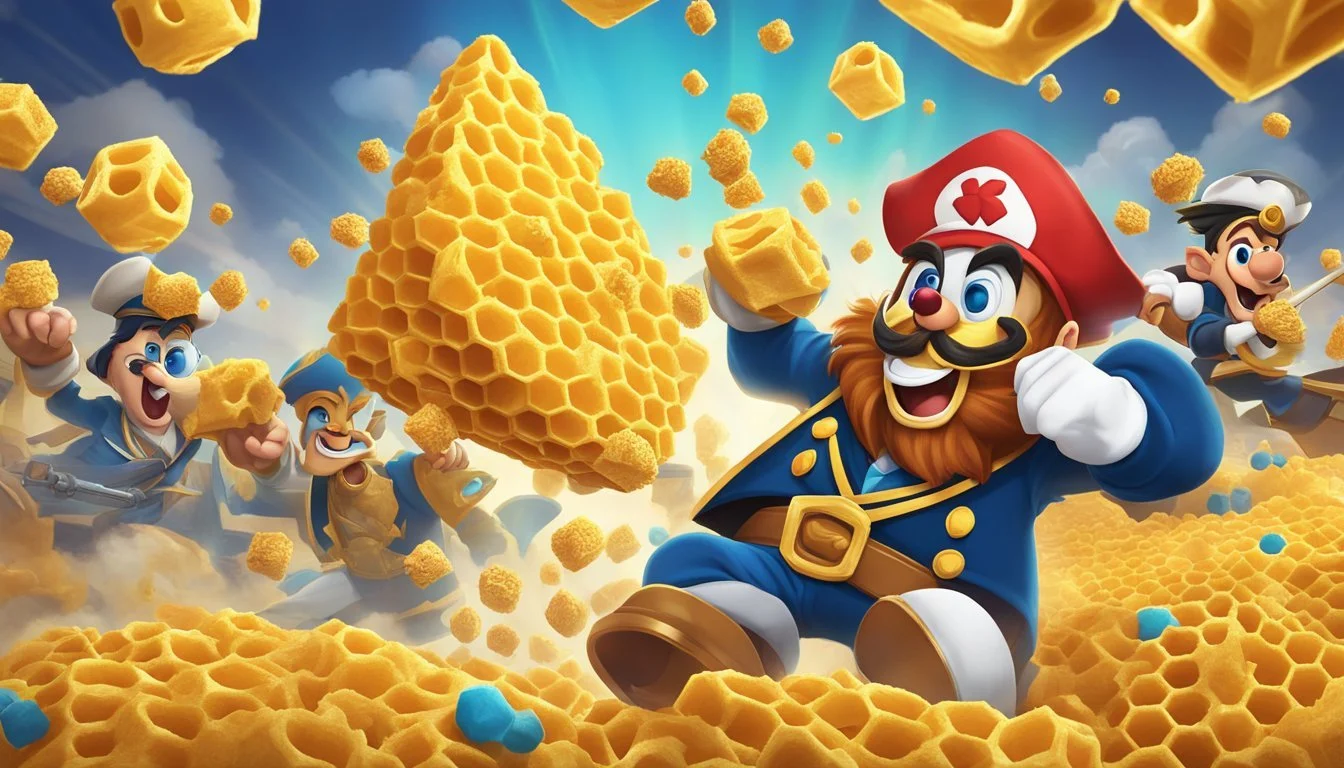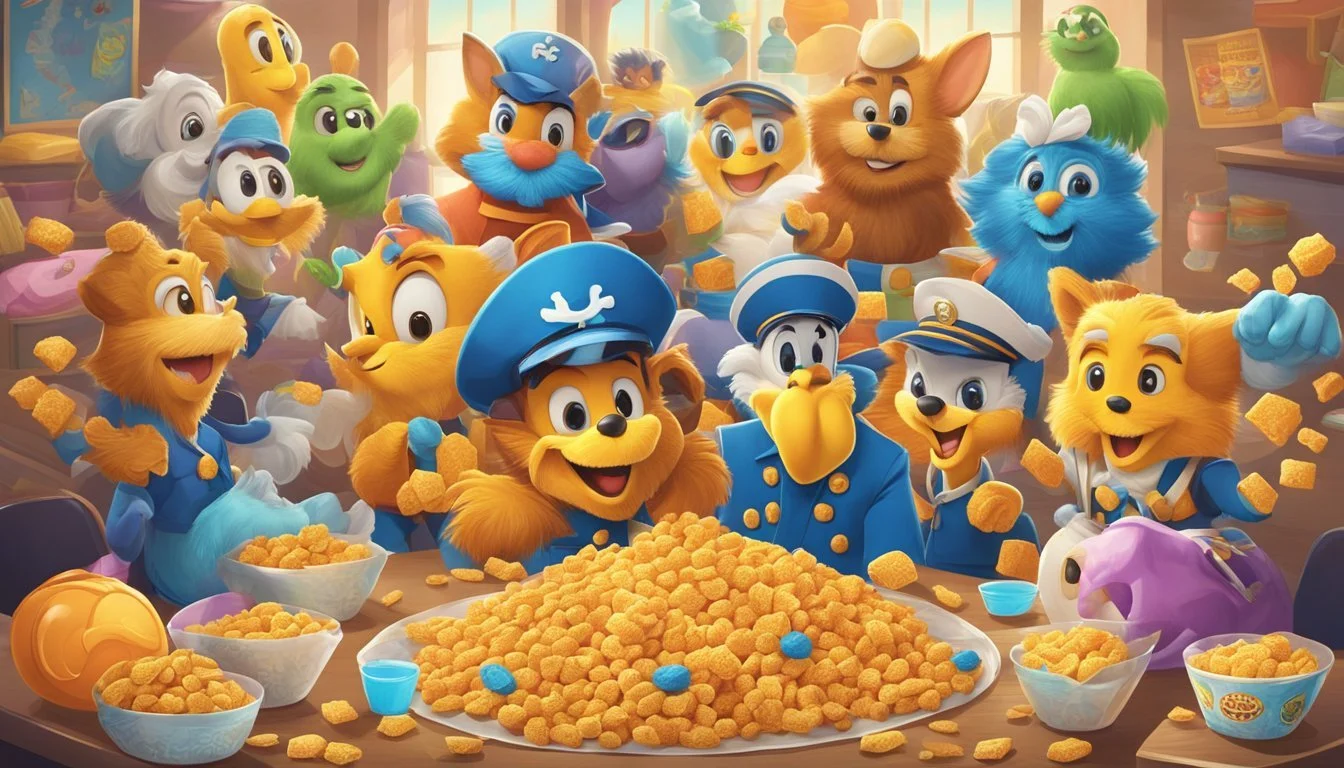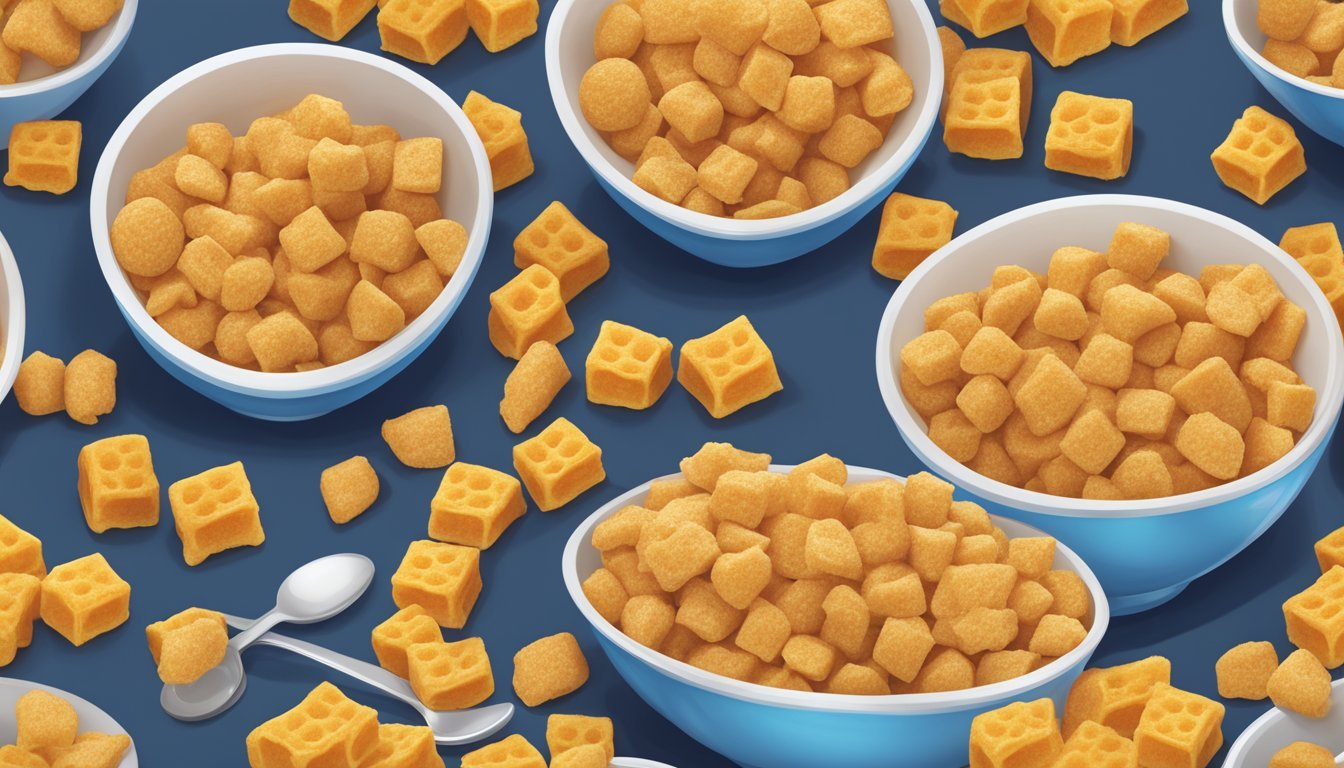Cap'n Crunch vs Honeycomb
Breakfast Cereal Showdown
This Article is Part of Our Breakfast Cereal Guide with Details on Cap'n Crunch Nutrition and Honeycomb Nutrition
Cap'n Crunch and Honeycomb are both beloved breakfast cereals that have earned a place on many kitchen shelves. Cap'n Crunch stands out with its higher content of Folate, Iron, and Zinc. This can make it particularly appealing to those looking to bolster their nutrient intake in these areas.
Honeycomb, on the other hand, offers a different set of benefits. It is richer in Vitamin B12, Vitamin A, and Vitamin D. These vitamins are crucial for maintaining overall health, making Honeycomb a valuable option for a balanced diet.
Both cereals provide a unique nutritional profile that can cater to different dietary needs. Whether you prioritize vitamins or minerals, there's a case for both Cap'n Crunch and Honeycomb in your breakfast routine.
History and Brand Overview
Cap'n Crunch and Honeycomb have rich histories that showcase their unique development, market presence, and evolution over the years. Here, we explore how each brand came to be and their significant milestones.
Developing Cap'n Crunch
Cap'n Crunch was introduced by Quaker Oats in 1963. The original flavor was developed by flavorist Pamela Low, who used her grandmother's recipe of brown sugar and butter over rice as inspiration. This innovative approach resulted in a sweet, crunchy cereal that quickly became popular.
Quaker Oats initially marketed Cap’n Crunch as a unique cereal for breakfast that stood out from others due to its distinct taste and texture. Over the years, additional flavors and variations, such as Crunch Berries and Peanut Butter Crunch, were introduced, expanding the brand's portfolio.
Cap’n Crunch's enduring appeal lies in its nostalgic value and the innovative marketing campaigns that kept it relevant across generations.
Honeycomb's Beginnings
Honeycomb cereal was introduced by Post in 1965, marking the brand’s entry into the ready-to-eat cereal market. It was designed to resemble honeycombs, offering a large, hexagonal shape that distinguished it visually from other cereals.
The cereal was initially promoted for its crunchiness and honey flavor. The marketing campaigns often emphasized its unique shape and size, appealing to both children and parents alike. The cereal became popular quickly, benefiting from targeted advertising and the novelty of its design.
Post continued to innovate with Honeycomb, occasionally tweaking the recipe to enhance flavor and nutritional value, which helped to maintain consumer interest over time.
Brand Evolution Over Time
Both brands have seen significant evolution. Cap’n Crunch expanded its product line with various flavors and occasional limited editions. The brand’s mascot, Cap’n Horatio Magellan Crunch, became a cultural icon, known for playful and adventurous advertising campaigns that resonated with children.
Honeycomb, produced by Post, also expanded with different flavor variants and special editions. The cereal maintained its core identity but adapted to changing consumer preferences by incorporating more nutritional elements and diversifying promotional strategies.
The evolution of these brands reflects broader trends in the cereal industry, where nostalgia and innovation help maintain their status among new and loyal customers. Both products have navigated challenges over decades, ensuring their place in American breakfast culture.
Nutritional Content Comparison
The nutritional content of Cap'n Crunch and Honeycomb cereals varies significantly, particularly in their vitamin and mineral profiles. This section details the differences in macronutrients, vitamins and minerals, and sodium and sugar content.
Macronutrient Breakdown
Cap'n Crunch has 120 calories per serving, while Honeycomb has 110 calories per serving. Both cereals provide 1 gram of protein per serving. The fat content is relatively minimal, with Cap'n Crunch having slightly more fat than Honeycomb cereal. Neither cereal offers a significant amount of fiber, which is essential for digestive health.
Vitamin and Mineral Comparison
Cap'n Crunch is richer in Folate, boasting 311% more daily need coverage than Honeycomb. It also surpasses Honeycomb in Iron, Zinc, Vitamin B6, Vitamin B2, Vitamin B1, and Vitamin B3. Specifically, Cap'n Crunch has 16.16mg of Zinc compared to Honeycomb’s 4.69mg.
Honeycomb, on the other hand, excels in Vitamin B12, Vitamin A RAE, and Vitamin D. These vitamins are vital for immune function and vision. Hence, those looking for a cereal with more long-term health benefits might prefer Honeycomb.
Sodium and Sugar Content
Sodium and sugar are critical factors to consider in cereal choices. Both Cap'n Crunch and Honeycomb cereals contain significant amounts of sugar. Cap'n Crunch offers some of the highest sugar content in cereals, while Honeycomb is not far behind. Exact figures on sodium content were not detailed in the results but are crucial for individuals monitoring blood pressure.
In summary, consumers should weigh these nutritional variants carefully based on their dietary needs and health goals. The differences in vitamins and minerals might sway one’s choice depending on what they prioritize in their diet.
Dietary Considerations for Consumers
When choosing between Cap'n Crunch and Honeycomb cereals, several dietary factors such as fat content, carbohydrates, caloric intake, and impact on blood sugar levels should be considered.
Low Fat and Low Carb Options
Both Cap'n Crunch and Honeycomb cereals have nutritional profiles that may influence dietary choices. Cap'n Crunch contains more saturated fats and trans fat compared to Honeycomb, which has lower fat content.
For those on low-carb diets, it's essential to note that both cereals are high in carbohydrates. Cap'n Crunch has slightly more net carbs than Honeycomb. Consumers aiming to reduce their carb intake should consider these differences carefully.
Considering a Low Calorie Diet
Caloric content is a crucial factor in dietary planning. A typical serving of Cap'n Crunch contains about 112 calories, while Honeycomb is similar. Both options may not significantly impact a low-calorie diet if consumed in moderation.
Portion control is vital since adding milk or other toppings can increase caloric intake. It's beneficial to compare the calorie content in conjunction with nutritional value to make informed choices.
Impact on Blood Sugar Levels
Blood sugar levels are influenced by the glycemic index of foods. Cap'n Crunch and Honeycomb cereals both contain high amounts of sugar, which can lead to rapid spikes in blood sugar levels.
For those on a low glycemic index diet, it's important to be aware that both cereals may have a high glycemic load. The added sugars in these products warrant caution for diabetics or anyone monitoring blood sugar levels.
Opting for smaller portions or pairing the cereals with protein-rich foods can help mitigate these effects.
Product Varieties and Flavors
Cap'n Crunch and Honeycomb offer distinct experiences through their unique flavors and varieties. Understanding these options helps consumers make more informed choices based on their taste preferences and nutritional needs.
Exploring Cap'n Crunch Varieties
Cap'n Crunch Cereal provides a range of flavors that appeal to various taste buds. Original Cap'n Crunch features its iconic golden squares with a sweet, buttery taste. Peanut Butter Crunch combines the classic crunch with a rich, peanut buttery flavor, making it a favorite among peanut butter lovers.
Crunch Berries adds vibrant berry-flavored crunch balls to the original formula, providing a fruity twist. Seasonal varieties like Christmas Crunch offer a festive mix with holiday-themed shapes and colors, making it a special treat for celebrations. Another notable variety is Cap'n Crunch's Chocolate Caramel Crunch, which merges chocolate and caramel flavors with the base cereal, creating a unique and indulgent breakfast option.
Variety Key Feature Original Cap'n Crunch Sweet, buttery-shaped squares Peanut Butter Crunch Rich peanut butter flavor Crunch Berries Fruity-flavored crunch balls Christmas Crunch Festive shapes and colors Chocolate Caramel Crunch Chocolate and caramel combination
Taste Testing Honeycomb Flavors
Honeycomb Cereal primarily sticks to its original flavor, which is known for its large, honey-flavored hexagonal pieces. The simple honey taste appeals to those who prefer a straightforward, less complex cereal. Occasionally, Honeycomb introduces limited-time flavors, though these are less frequent than the variations seen in Cap'n Crunch.
The original flavor's honey sweetness pairs well with milk, offering a satisfying crunch that stays consistent. When special editions are released, they often play with various sweet or fruit-oriented undertones without straying far from the beloved honey baseline.
Overall, Honeycomb’s consistency in flavor helps maintain its loyal fan base, providing a reliably enjoyable breakfast experience without the frequent changes seen in other cereals.
Consumer Experience and Loyalty
When comparing Cap'n Crunch and Honeycomb cereals, consumer experience plays a pivotal role. This encompasses aspects such as texture, taste, brand recognition, and nostalgia, influencing loyalty.
Texture and Taste Profiles
Cap'n Crunch features a distinctive crunchiness, satisfying those who enjoy a more crispy texture in their breakfast. It’s known for its sweet and somewhat buttery flavor, which appeals to both children and adults.
In contrast, Honeycomb offers a lighter, airier texture with a milder honey flavor, making it less intense but equally enjoyable.
Serving sizes for both cereals are typically around 30 grams. Ingredient-wise, Cap'n Crunch includes sugar, oats, and flavoring additives, while Honeycomb primarily contains corn flour, sugar, and a hint of honey.
These textural and flavor differences cater to varying consumer preferences.
Brand Recognition and Nostalgia
Cap'n Crunch, introduced in 1963, has built a strong brand presence. The character Cap'n Horatio Magellan Crunch is iconic, contributing to the brand’s nostalgic value. Many consumers associate childhood memories with this cereal, deepening their loyalty.
Honeycomb, launched in 1965 by Post, also enjoys significant brand recognition. Its unique honeycomb shape and sweet, honey-infused taste resonate with those who grew up enjoying this cereal.
Advertising campaigns and promotional tie-ins have further strengthened both brands. Nostalgia plays a crucial role here, as many adults choose these cereals to relive a part of their youth, ensuring continued consumer loyalty across generations.
Market Presence and Availability
Both Cap'n Crunch and Honeycomb have significant market presence with wide availability in grocery stores and online. They are staples in the cereals ready-to-eat category, each backed by major companies, General Mills and Kellogg's, respectively.
Grocery Store Placement
Cap'n Crunch and Honeycomb enjoy prominent placements in grocery stores. They are usually found on middle shelves, where they are easy for consumers to spot and grab. Both cereals benefit from strategic positioning near the more popular items, leveraging their brand recognition.
Cap'n Crunch often features in end-cap displays, especially during promotional periods. This cereal's bright packaging and frequent discounts help attract impulse buyers.
Honeycomb, with its distinctive yellow box, also garners eye-level placement. It often appears in family-oriented aisles, targeting shoppers looking for nutritious options for children.
Online Accessibility
Both Cap'n Crunch and Honeycomb are widely available through major online retailers. Consumers can purchase these cereals from websites like Amazon, Walmart, and the official websites of General Mills and Kellogg's, ensuring easy access.
Cap'n Crunch offers a range of flavors which are listed in various online stores, with user reviews and ratings contributing to informed purchasing decisions.
Honeycomb, similarly, is featured on numerous e-commerce platforms. Its availability may include value packs and subscription options, catering to those who prefer buying in bulk or ensuring regular deliveries.
Convenience and competitive pricing bolster their online presence, appealing to a broad audience who values effortlessness in grocery shopping.
Comparative Analysis with Similar Products
When comparing Cap'n Crunch and Honeycomb Cereal, it's crucial to look at their nutritional content, flavor profiles, and consumer preferences relative to other popular cereal brands.
Cap'n Crunch vs Other Brands
Cap'n Crunch stands out with its sweet, buttery flavor and crunchy texture, making it a favorite among kids and adults alike. Cap'n Crunch provides 120 calories per serving, with 1 gram of protein. It is richer in Folate, Iron, Zinc, and Vitamins B6, B2, B1, and B3 compared to some competitors, but it is less nutritious in other aspects.
For example:
Frosted Flakes offers 110 calories per serving, with more protein at 2 grams per serving.
Cinnamon Toast Crunch is higher in sugar but provides a bold cinnamon flavor that Cap'n Crunch lacks, with 130 calories per serving.
Honey Nut Cheerios balances sweetness and nutrition, also providing heart health benefits with 140 calories and 2 grams of protein per serving.
Choosing Cap'n Crunch over others may come down to taste preference and specific nutritional priorities.
Honeycomb Comparisons within the Market
Honeycomb Cereal distinguishes itself with a light, airy texture and honey-flavored sweetness. It offers 110 calories per serving with 1 gram of protein. Honeycomb is higher in Vitamin B12, Vitamin A RAE, and Vitamin D but lower in certain minerals compared to other cereals.
For instance:
Mini Wheats give a different texture and nutritional benefits, with 6 grams of protein and 210 calories per serving.
Honey Bunches of Oats combines a mix of textures and richer nutritional value at 120 calories and 2 grams of protein per serving.
Cocoa Puffs delivers a chocolaty experience with higher sugar content and 100 calories.
When lined up with its market counterparts, Honeycomb appeals to those preferring a milder sweetness and a lighter cereal experience.
These comparisons help consumers decide based on taste, nutritional content, and dietary needs.
Key Takeaways and Final Thoughts
Cap'n Crunch and Honeycomb offer a variety of nutritional benefits and considerations.
Cap'n Crunch Cereal is notably higher in several essential vitamins and minerals. For Folate, it provides 311% of the daily need coverage. It also has significantly more Zinc, with 16.16mg compared to Honeycomb's 4.69mg.
Honeycomb Cereal, on the other hand, excels in providing Vitamin B12, Vitamin A RAE, and Vitamin D.
Vitamins Daily Need Coverage Scores:
Cap'n Crunch:
Folate: 311%
Vitamin B6, B2, B1, B3: High coverage
Honeycomb:
Vitamin B12: Higher coverage
Vitamin A RAE: Higher coverage
Vitamin D: Higher coverage
Minerals Daily Need Coverage Scores:
Cap'n Crunch:
Zinc: 16.16mg
Honeycomb:
Zinc: 4.69mg
Individuals looking for higher Folate intake might prefer Cap'n Crunch, whereas those focusing on Vitamin B12 and Vitamin D might lean towards Honeycomb.
Ultimately, both cereals offer unique benefits, making them suitable choices depending on specific nutritional needs.









